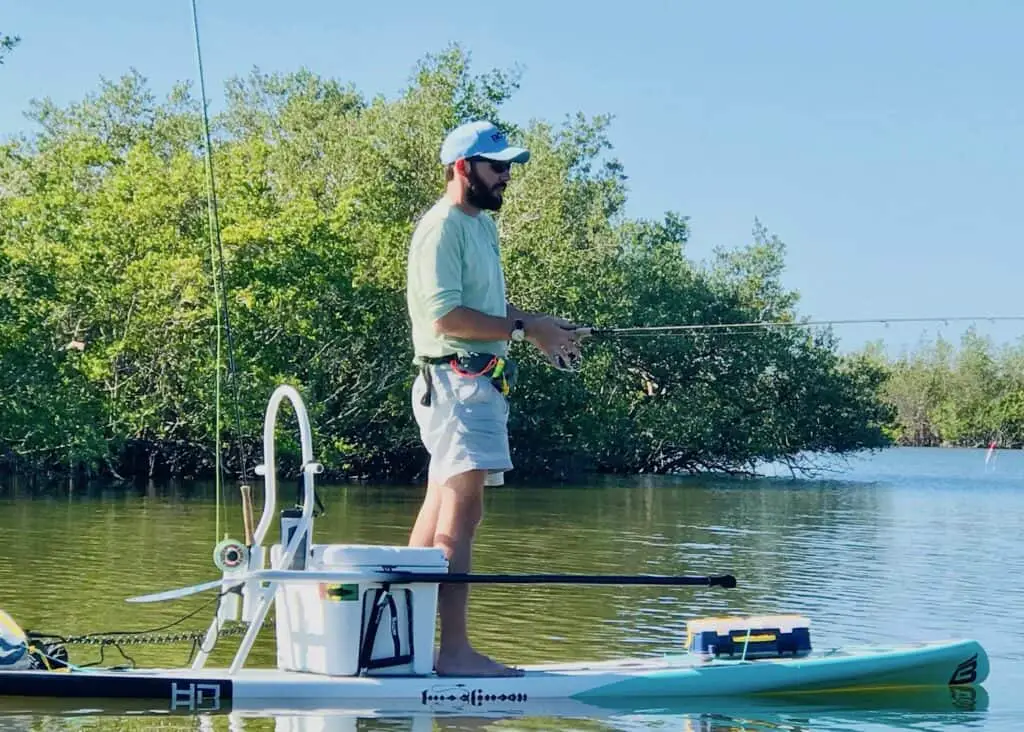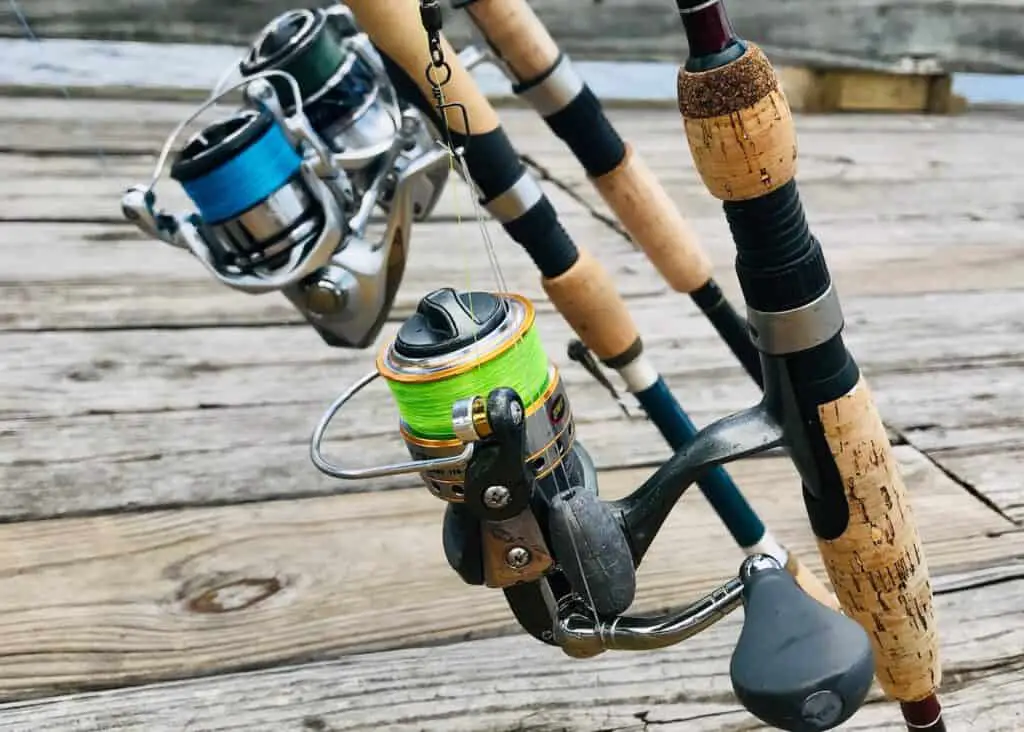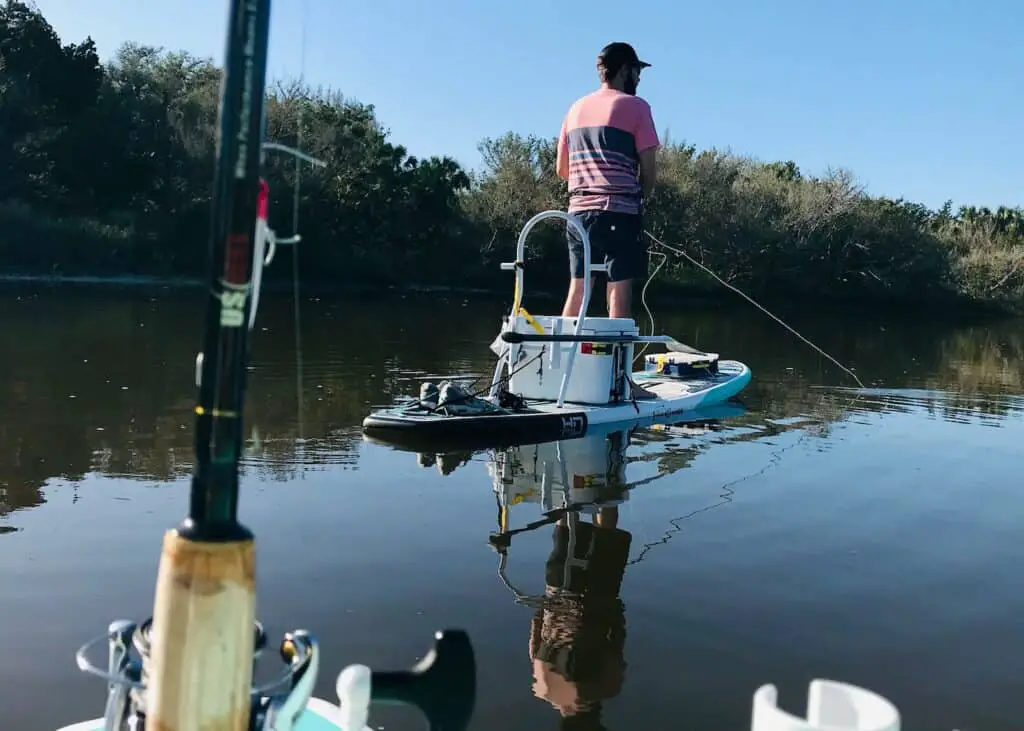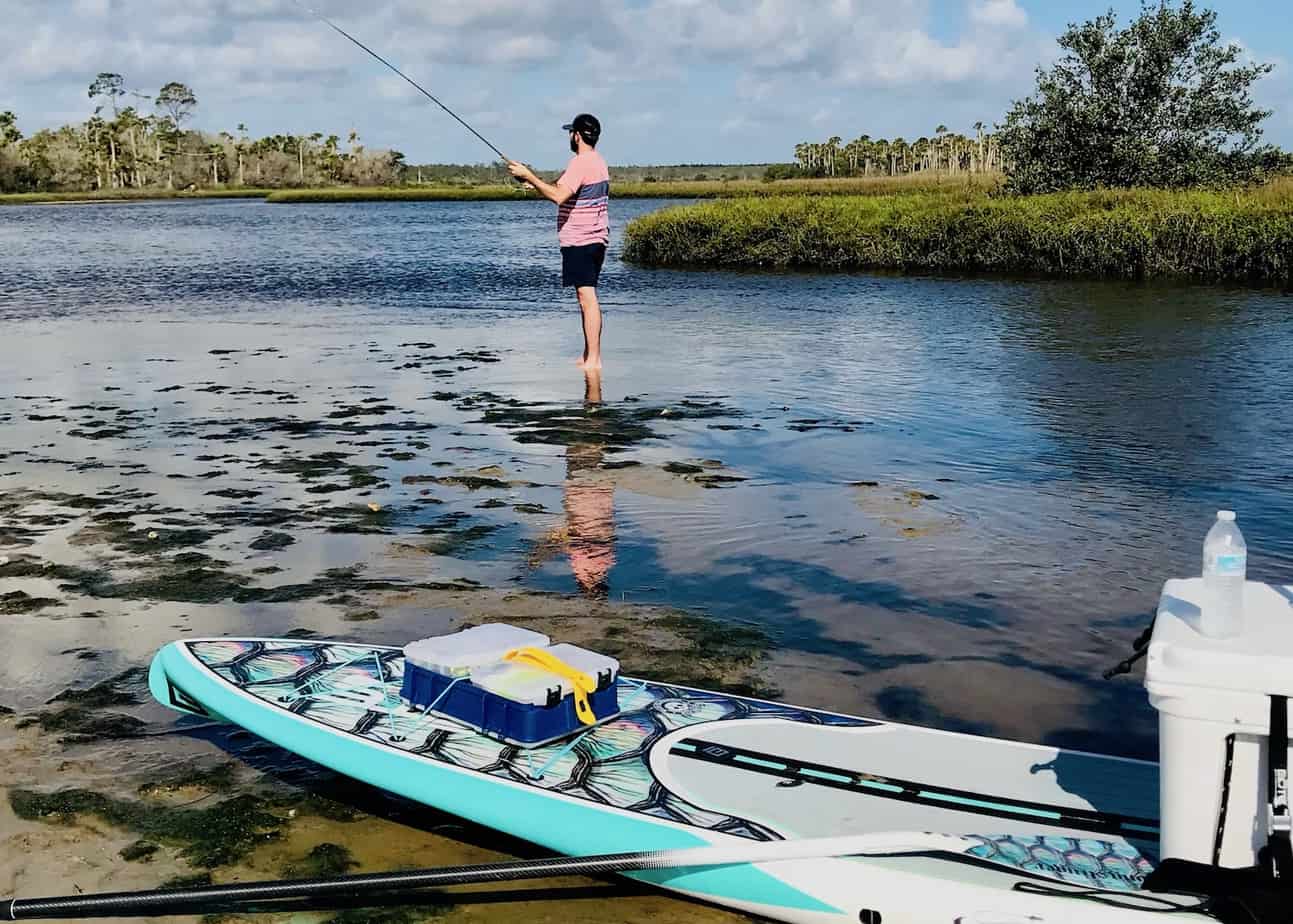Whether you’re taking in the mountain view from a freshwater fishing spot, or you have your sea legs on the open ocean and you’re casting lines for a big catch, you want the right tackle. And, there are plenty of differences between what you need for saltwater and freshwater fishing.
The main difference between saltwater and freshwater tackle is that saltwater tackle is usually constructed of higher quality materials, such as titanium, stainless steel, and carbon that are corrosion resistant. Additionally, saltwater tackle is generally more robust in order to handle larger, more aggressive fighting fish.
You want to make sure you have the right gear for the right job. So, what’s the difference and how do you know what to bring? Keep scrolling to make sure you have everything you need for your next great catch.
Understanding the difference between saltwater and freshwater fishing
Before we get into the tackle, there are a few key differences that inform each type of fishing. Bodies of freshwater, like lakes, rivers, and ponds, offer generally serene locations to cast out a line. Freshwater fish are typically smaller, there are fewer of them in fresh waterways, and there’s a relaxed vibe to the hobby.
Saltwater is a different world. Ocean fish are larger, and the environment can be more harsh regardless of whether you’re talking about the salt and minerals in the water, rougher surf, or bigger fights.
The types of fish you catch vary greatly between the two environments, too, requiring different hooks, bait, reels, and other tackle needed for a successful catch.
No matter where you are, you’ll want to have the right tackle gear at hand—while there are a few things that will do well in both environments, most tackle is made with either fresh or saltwater in mind.
Freshwater Fishing Tackle
Because freshwater gear does not need to withstand the harsh saltwater environment, it also tends to be less expensive and last for a long time with the proper care. This is a great entry into fishing for the new fisherman because it gives you a taste of the sport without requiring you to go all-in. Plus, you don’t necessarily need a boat: freshwater is found pretty much everywhere.
Before we get into the specifics, we just want to point out that freshwater tackle is generally not recommended for saltwater fishing. Sure, in a pinch or for short durations, you can use a freshwater rod and catch some fish on the ocean. But the materials used in freshwater fishing tackle are not meant for prolonged periods of exposure to brackish or true saltwater environments. Check out some tips to keep your reels in great shape, no matter where you use them.
Freshwater Rods and Reels
Freshwater rods are generally lightweight rods that are much smaller and less rigid when compared to saltwater fishing rods. Freshwater rods are more geared toward precision and sensitivity vs casting distance and/or power like with saltwater rods. This is because, with freshwater fishing, anglers need to get their lures into very tight spots without getting hung on limbs and structure and also need to feel lighter bites to set up for a good strong hookset.
Freshwater rods are typically rated as extra light to heavy power, with a max line rating under 20lb, a lure weight rating than 1oz, a length under 7 ½ ft, and a moderate to extra-fast action.

These ranges of freshwater rods account for nearly every type of freshwater fishing, excluding fly fishing, that you can do and nearly every type of freshwater fish you can catch. Depending on what you are fishing for will determine where within these ranges is best. If you are fishing for small crappie, for example, an extra light rod may be ideal where you may want a heavy power rod for bass fishing.
Here are a few of our favorite freshwater fishing rods in both the spinning and casting categories:
Spinning
Casting
Lines and Leaders
No matter what, your fishing lines and leaders should accommodate the types of fish you’re looking to catch. You can keep these pretty simple, especially to start: in relatively freshwater, you want a thin, clear line that won’t draw extra attention to the fact that you’re on the other end of it.
There are two types of line that are commonly used in freshwater fishing, braid and monofilament. Depending on the style of fishing you are doing and the equipment you are using will determine what type of line is best. For example, when fishing around structure, monofilament may be preferred for its superior abrasion resistance.
For freshwater fishing, the size of the mainline will be anywhere from 4lbs up to 12lbs. Where in this range is best for you? That will depend on the fish you are targeting. For most bass fishing applications, 6lb to 8lb test line is recommended.
If you are fishing with braid as your mainline, you will additionally want a good leader line. Some fishermen will also use a leader line when using mono as the mainline, but generally, fishermen tend to just attach the lure directly to the mainline with mono.
The leader line is usually either monofilament or fluorocarbon. Again, your application will determine what the best leader line is to use. In general, most fishermen prefer fluorocarbon for the leader line for its reduced visibility and its durability.
For freshwater fishing, the leader line is needed more for bait presentation than it is for additional strength or durability like with saltwater fishing. The size of your leader line again depends on the fish you are targeting, but should generally be anywhere from 4lb test up to 15lb test.
No matter what type of line you’re using, there is one thing that is consistent: presentation is everything and line visibility is your enemy. This means you want a line and leader combination that is nearly invisible to the fish in order to reduce spooking the fish.
Here are a few of our recommendations for the main fishing line in both braid and monofilament as well as some recommendations for the leader line.
Give it a try: SpiderWire Stealth, Berkley Vanish, and Berkley Trilene are tried and tested.
Freshwater Hooks
The best type of hook will vary based on the type of fish you’re after. Freshwater fishing hooks are aptly named, describing their purpose right off the bat.
- Worm Hook
- Bait Holder
- Treble Hook
- Circle Hook
The worm hook is most popular for soft plastic artificial lures such as worms, minnows, shads, and other swimbaits. A big perk with these hooks is that, with their offset shank, these hooks can be rigged as a weedless hook which allows you to fish around grass, lily pads, and other vegetation without getting snagged.
Treble hooks are mostly used in conjunction with jerk baits and other hard artificial lures. In general, especially if you are practicing catch and release fishing, a treble hook is not recommended as it tends to cause a lot of damage to the fish. However, they are very effective at increasing your hookup rate.
Popular in catch-and-release fishing, circle hooks offer a gentler experience for the fish and are easier to unhook and release. A prolonged fight while trying to unhook a fish can defeat the point of catch-and-release, causing injury and trauma to the fish.
Freshwater Lures, Bait, Weights, and Floats
Freshwater fish may be more attracted to artificial lures that look like the small fish and worms they are used to seeing. In some instances, live bait is prohibited in freshwater ways, including in most national parks in the United States. Be sure to check local regulations before heading out.
Light lures are for higher up in the water column, and you can work them on or close to the surface. The heavier the lure, the further down it will sink, getting you closer to your catch more quickly.

Depending on the water clarity where you’re fishing, you may want to look for something with bright colors that will stand out to fish in a murky environment.
Although not necessary for the novice fisher, weights are a great way to extend your cast, and floats help you see when a fish has taken your bait. This can take a little practice, but with some trial and error, you’ll see that these accessories can up your fishing game.
Saltwater Fishing Tackle
In general, saltwater fishing tackle needs to be made to a higher quality standard to withstand not just the corrosive saltwater environment, but also the additional wear and tear put on the gear during saltwater fishing.
Bigger fish combined with deeper and rougher waters means you might have a little bit more of a fight to get your catch on board safely. The last thing you want when reeling in a catch is for a rod to break or your equipment to fail.
Because saltwater gear is a little bit more of an investment, you can get the most out of it by properly cleaning your gear with clean, freshwater as soon as you are able.
Saltwater Rods and Reels
Saltwater rods are meant to be durable, accommodate heavier line and lures, and are designed for a sealed reel, specially designed for saltwater use. These rods, often made out of carbon fiber, are meant for larger fish, a more prolonged fight on the water, and are more rigid as a result.
Here are a few of our favorite freshwater fishing rods in both the spinning and casting categories:
Spinning
Casting
Saltwater reels are specifically enclosed to prevent corrosion from the elements. Just like with freshwater gear, you want to match the rod to the reel. If you’re in the market for a good spinning reel, check out our take on the best spinning reels for saltwater.
Saltwater Lines and Leaders
Stronger fish, currents, and harsher conditions in general call for durable lines and leaders. There’s nothing like putting up a good fight, and just when you’re about to catch a glimpse of that fish on the other end of the line—snap!—they’re off, back into the water, and you’re starting from the beginning again.
Monofilament lines are popular among saltwater fishers for their subtlety and strength, a winning combination.
Saltwater Hooks
Just like with lines, you want to match the type of hook you’re using to the fish you’re trying to catch and the environment they like to hang out in. If you’re going for deeper fish or trying to snag a tuna, you’ll want a heavy gauge hook.
Otherwise, the standby circle hook is a great choice for saltwater fishing, too.
Lures, Bait, Weights, and Floats
More often we see fishers using live bait for saltwater fishing. Common bait includes shrimp, shellfish, and other baitfish like eels. Ocean fishing may feel like you’re trying to catch a little fish in a big sea, but fish have a great sense of smell. Give it some time—they’ll find you!
It can’t hurt to have some lures like flutter jigs and bucktail jigs handy, both versatile lures for many different depths.
On the open ocean you want to be sure you have the right type of weights to bring your bait to the right depth. They’ll also be in the water for a good amount of time, so choosing a high-quality weight and float will save you money in the long run.
Tackle Suitable for both Freshwater and Saltwater/Interchangeable Tackle
While most tackle is designed with a specific intent, that doesn’t mean that you can’t use it interchangeably in freshwater and saltwater.
Rods
Just like squares are rectangles, but not all rectangles are square, this concept applies to rods. A saltwater rod can be used in freshwater fishing. It won’t offer the most flexibility as a freshwater rod, but it will certainly help you get the job done.
The same is not necessarily true for using freshwater rods in saltwater. We strongly recommend against this, unless you are able to quickly wash the rod in freshwater, as the corrosive environment will cause a freshwater rod to quickly deteriorate.

Knives and Scissors
Aside from some sort of multi-tool sheathed pocketknife that you should always have on you while fishing, if you plan on cooking your catch, you’ll want to have a good fillet knife at-hand. First and foremost, you want to pick a high-quality blade that won’t rust easily.
Filet knives are typically thin, sharp, and a decent size. These delicate, sharp blades lead to a cleaner filet, reducing the amount of fish bones you might find in your hard-earned meal and offering clean cuts to filet fish. You can get a plain edge blade, micro-serrated, or serrated blade depending on the types of fish you’re catching. The more serrated the blade, the more of the fish you will sacrifice during preparation.
You’ll also want to include a high-quality pair of multi-functional scissors in your tackle box for cutting line or any number of tasks, and a pair of needle nose pliers for removing hooks and more.
Comfort and safety are important qualities when picking out any type of blade or tool you’ll be using in or around water: you want something with a good grip so that you don’t accidentally injure yourself or others, and you want it to feel comfortable in your hands.
What we like: Bubba brand offers filet sets with interchangeable blades, carrying cases, and protective sheaths for safety, plus scissors that will last.
Lures
Notably, there are several lures that will serve you well in any environment like artificial shrimp, topwater jerkbait (in the right light), saltwater spinnerbaits, and crankbait to name a few.
Tackle Boxes and Spare Equipment
Tackleboxes offer vital waterproof protection for your gear. When picking out a tackle box, or a bag, keep in mind the weight, organization, and size. No matter where you’re going, it can’t hurt to have a small first aid kit, needle nose pliers, extra lures, plastic worms, bobbers, and of course extra line and extra hooks.
Tackle boxes can be one of the heaviest things you take on your fishing trip, so keeping it manageable will allow you to remain agile and safe while moving from spot-to-spot. Don’t forget to throw in a bottle of sunscreen.
What to buy? Options abound for storing your gear: tackle storage ranges in size from small to large and you can pick from boxes or bags. The price ranges accordingly—simple tackle storage could be as cheap as $10 or set you back several hundred depending on features. Flambeau, Calissa, Yeti, and Plano have been around for a long time and have options to meet all of your needs.
Clothing, Footwear, and Accessories
It’s not necessary to immediately invest in fishing-specific clothing like fishing vests or waders—you probably have enough in your closet right now to get started. Clothes you don’t mind getting wet, footwear for the terrain you’ll be on, a hat, and sunglasses will get you a good start.
Over time you may want to invest in fishing gear for conveniences, such as clothing with lots of pockets, waterproof waders and boots, and other non-slip fishing-specific footwear to prevent slips and trips. And of course, clothing with UV protection will protect your skin from long hours in the sun.
Time to cast your line
Before you head out, be sure to consult local fishing regulations. Knowing the rules around catch and release of native species, limitations or rules around different types of bait in various waterways, and other local regulations can help you plan a successful trip.
Freshwater fishing is a great, less expensive way to start out in your fishing journey. But if you’re looking for the thrill of a big catch and open ocean air, saltwater is your best bet. No matter what your preference, be sure to pick the right gear for maximum enjoyment!
Tight Lines and High Tides, y'all!
Recent Posts
Fat Cow Jig Strips: The Ultimate Bucktail Jig Upgrade for Surf Fishing
As discussed in my previous article, "Surf Fishing with Bucktail Jigs: Ultimate Guide for Beach Anglers," bucktail jigs are a staple in any surf angler's tackle box, offering a versatile way to catch...
In my previous article, "Surf Fishing with Bucktail Jigs: Ultimate Guide for Beach Anglers," I introduced you to the bucktail jig and discussed how versatile of a lure it is for catching a wide range...

